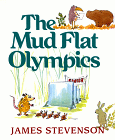The Mud Flat Olympics

by James Stevenson. ![]() Picture Book. 32 pages. Grades 1-4.
Picture Book. 32 pages. Grades 1-4.
Find this book: Amazon

Teacher's Guide

This article is a sample from the book Picturing Math by Carol Otis Hurst and Rebecca Otis which is no longer in print. The second edition, Picture Book Math is available as an eBook on CD at http://www.carolhurst.com/products/pbmcd.html.
The animals are having their own Olympics and, in four short chapters, plus a preface and epilogue, Stevenson presents their efforts in a mock serious tone. We begin with the carrying of the torch by Burbank. Then the contests begin. There are three contestants for the deepest hole contest though one elderly mole, Mr. Crenshaw, gives up early.
The judging of the winner is difficult, of course, because we have no one’s word for how deep they went except their own. The All-Snail High Hurdles race is apparently a tie. (Again, we seem to have missed the actual race.) Hardest on the judges is The Smelliest Skunk contest, but they stay the course and rate each on a scale of one to ten. The River Cross Free Style shows up a cheater, but all is well at the end.
Many of the math activities in this delightful book are obvious but try to keep them at the same playful level of as the book itself. This romp is too giddy to weigh down with "work" and yet a perfect opportunity to play with math.
(Continued Below)
Advertisement:

Activities
- K-Grade 2
Data Gathering & Analyzing
What evidence is there in the first contest that any digging was done? What evidence is there that the two contestants dug deeply? What evidence is there that they went as far as they said they did? What evidence could there have been? What would you have awarded them prizes for?
In the second contest, what evidence is there that the snails went over the hurdles? What evidence is there that they reached the finish line? What evidence could there have been? - PreK-Grade 2
Data Gathering & Analyzing
What do you think happened when Sid disappeared at the top of the hurdle? - K-Grade 2
Estimation
Look at the snail hurdles and the size of the animals. Find an object in your classroom that you think is about as high as the hurdles are. - PreK-Grade 2
Attributes & Classification
Make a list of the different animals in the book. (You might have to guess what some of them are.) Then list the special skills each animal would have. Make up some Olympic contests in which they would do well and others in which they would probably not do well. - Grades 1-2
Estimation & Computation
Read the poem "Ants at the Olympics" in the anthology The Random House Book of Poetry for Children (Random House, 1983. ISBN 0-394-85010-6). Compare their Olympic events to these. Would the ants have been better at the hurdles than the snails? Would they have been faster? What about the other events in the book? Which ones would the ants have failed at? Which events would take longer if you substituted the ants for one of the other animals? How long do you think the digging contest would take if the ants were the diggers? - PreK-Grade 1
Numeration
Which race had the most contestants? Which one had the fewest? - Grades 1-2
Numeration
At the end of the book, Crocker turns up with cookies for everybody. How many cookies should he have if everybody gets one?
(Continued Below)
Advertisement:
(Continued Below)
Advertisement:

Related Areas Within Carol Hurst's Children's Literature Web Site
- Picture Book Math by Carol Otis Hurst and Rebecca Otis
Sample chapters, Table of Contents and Ordering Information.
http://www.carolhurst.com/products/pbmcd.html - Children's Books in the Math Curriculum
Featured Subject with articles, books reviews and links.
http://www.carolhurst.com/subjects/math/math.html - Free Teacher's Guides: A listing of all our teacher's guides. Picture Books, Nonfiction and Fiction.

